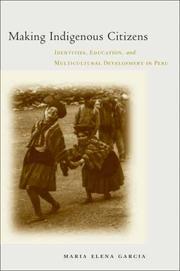| Listing 1 - 7 of 7 |
Sort by
|

ISBN: 0804750149 0804750157 9780804750141 9780804750158 Year: 2005 Publisher: Stanford (Calif.): Stanford university press,
Abstract | Keywords | Export | Availability | Bookmark
 Loading...
Loading...Choose an application
- Reference Manager
- EndNote
- RefWorks (Direct export to RefWorks)
Quechua Indians --- Multiculturalism --- Citizenship --- Ethnic identity --- Civil rights --- Education --- Cuzco (Peru : Department) --- Ethnic relations --- Social policy --- Politics and government --- #SBIB:328H32 --- #SBIB:39A74 --- Kechua Indians --- Kichwa Indians --- Napo Kichwa Indians --- Quichua Indians --- Indians of South America --- Cultural diversity policy --- Cultural pluralism --- Cultural pluralism policy --- Ethnic diversity policy --- Anti-racism --- Ethnicity --- Cultural fusion --- Birthright citizenship --- Citizenship (International law) --- National citizenship --- Nationality (Citizenship) --- Political science --- Public law --- Allegiance --- Civics --- Domicile --- Political rights --- Instellingen en beleid: Midden en Latijns-Amerika --- Etnografie: Amerika --- Government policy --- Law and legislation --- Cuzco (Peru : Region) --- Región de Cusco (Peru) --- Cusco (Peru : Department) --- Cuzco (Peru : Dept.) --- Qosqo (Peru : Department) --- Ethnic relations. --- Politics and government. --- Social policy. --- Quechua Indians - Ethnic identity --- Quechua Indians - Civil rights --- Quechua Indians - Education --- Multiculturalism - Peru - Cuzco (Department) --- Citizenship - Peru - Cuzco (Department) --- Cuzco (Peru : Department) - Ethnic relations --- Cuzco (Peru : Department) - Social policy --- Cuzco (Peru : Department) - Politics and government
Book
ISBN: 0520972309 Year: 2021 Publisher: Oakland, California : University of California Press,
Abstract | Keywords | Export | Availability | Bookmark
 Loading...
Loading...Choose an application
- Reference Manager
- EndNote
- RefWorks (Direct export to RefWorks)
In recent years, Peru has transformed from a war-torn country to a global high-end culinary destination. Connecting chefs, state agencies, global capital, and Indigenous producers, this "gastronomic revolution" makes powerful claims: food unites Peruvians, dissolves racial antagonisms, and fuels development. Gastropolitics and the Specter of Race critically evaluates these claims and tracks the emergence of Peruvian gastropolitics, a biopolitical and aesthetic set of practices that reinscribe dominant racial and gendered orders. Through critical readings of high-end menus and ethnographic analysis of culinary festivals, guinea pig production, and national-branding campaigns, this work explores the intersections of race, species, and capital to reveal links between gastronomy and violence in Peru.
Food --- Social aspects
Book
ISBN: 8873016502 9788873016502 Year: 2008 Publisher: Rome: Gremese,
Abstract | Keywords | Export | Availability | Bookmark
 Loading...
Loading...Choose an application
- Reference Manager
- EndNote
- RefWorks (Direct export to RefWorks)
Le Mouvement Créatif vise à développer les potentialités expressives et créatives du corps à travers l'improvisation, tout en en récupérant l'écoute profonde. Ce volume se rattache aux études qui sont faites sur le sujet en Europe, mais il est le premier qui décrive et approfondisse en particulier le profil et les caractéristiques de la méthode élaborée par Maria Elena Garcia et Marcia Plevin. Les deux premières sections en analysent les fondements théoriques et pratiques ainsi que les plus importantes applications didactiques. La troisième partie, traitée par Patrizia Macagno, explique le bien-fondé de la méthode dans la formation des danseurs et des enseignants. Elle y souligne surtout la capacité de cette méthode à diminuer les conditionnements psychologiques et techniques des élèves, tout en libérant leur sensibilité et leur imagination. Depuis 2001, le Mouvement Créatif est devenu une discipline de base dans les cours de maîtrise de l'Accademia Nazionale di Danza de Rome, grâce à son efficacité et à sa modernité.
Book

Year: 1998 Publisher: New York (N.Y.) : UNDP,
Abstract | Keywords | Export | Availability | Bookmark
 Loading...
Loading...Choose an application
- Reference Manager
- EndNote
- RefWorks (Direct export to RefWorks)
Multi

ISBN: 9780823283675 9780823283644 Year: 2019 Publisher: New York, N.Y. Fordham University Press
Abstract | Keywords | Export | Availability | Bookmark
 Loading...
Loading...Choose an application
- Reference Manager
- EndNote
- RefWorks (Direct export to RefWorks)
Book

ISBN: 082328364X 0823283666 0823283674 Year: 2019 Publisher: Fordham University Press
Abstract | Keywords | Export | Availability | Bookmark
 Loading...
Loading...Choose an application
- Reference Manager
- EndNote
- RefWorks (Direct export to RefWorks)
Book

ISBN: 9780823283675 Year: 2019 Publisher: New York, NY
Abstract | Keywords | Export | Availability | Bookmark
 Loading...
Loading...Choose an application
- Reference Manager
- EndNote
- RefWorks (Direct export to RefWorks)
| Listing 1 - 7 of 7 |
Sort by
|

 Search
Search Feedback
Feedback About UniCat
About UniCat  Help
Help News
News